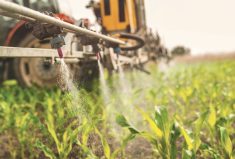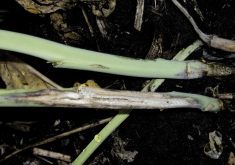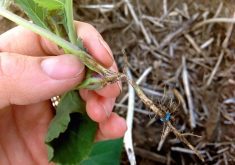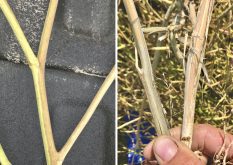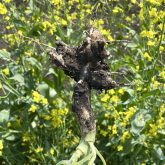It seems people don’t question the need to spray fungicide any longer.
“A lot more producers are more aware of diseases and are making the decision to spray fungicide a lot more than they used to,” said Mark Cutts, a crop specialist with Alberta Agriculture’s Ag Info centre in Stettler.
“That goes across the province (and) across the Prairies in general.”
Shaun Kinniburgh has noticed increasing fungicide use, too.
Read Also

Hail research hopes to benefit potato growers
Alberta research scientist measures hail storm and heat dome affects on potato crops
“Herbicide used to be how we made a living,” said the third-generation applicator and owner of Kinniburgh Spray Services in Taber.
“In 2013, we did less than 3,000 acres of herbicide. Fungicide is now about 85 per cent of our work most years.”
Leaf diseases in wheat and barley are a common target but this year, many producers are also spraying their canola for sclerotinia, and that’s becoming even more common as canola acreage increases.
“When you get more of the same type of crop in an area, you’ll eventually start seeing diseases cropping up,” said Pat Stinnissen, co-owner of Quikway Air Services in Brooks.
But despite all the wet weather, business is a little bit slower this year.
“We’re steady, but we’re not overloaded like we have been the last couple of seasons,” he said.
- From the Grainews website: Manitoba aerial sprayers flooded with business
He hasn’t been spraying as much fungicide in wheat this year as in the past because the area in Newell County has been a little bit drier.
“Fungus and spores like humidity and the wetness, which promotes fungal growth and leaf disease. So we have not been getting that humid, wet weather here this year so far, compared to the last two seasons.”
Over in Taber, Kinniburgh is also seeing a slow start to his season. In a July 10 interview, he said things are slower because southern crop staging is about two weeks behind normal. He covers most of the southern region, with spraying potatoes for late blight disease control accounting for a good part of his work. He also sprays wheat for rust and net blotches, and peas and lentils for ascochyta blight, and is generally spraying different crops from the end of June until September.
Moist, wet conditions in the south could create additional disease pressure in that region, and a continued rise in spraying, he said.
“We’re spraying in areas that four years ago, you didn’t see much spraying in. You’d only spray there for bugs most of the time,” said Kinniburgh.
As always, scouting remains the key step in deciding whether to apply fungicide, said Cutts.
“You can’t just use a calendar as an estimate — to maximize the benefits of the fungicide, you need to scout those fields, get the crop stage right, get the right fungicide and go ahead and spray,” said Cutts.
“If disease is at a low level, then there may not be a huge benefit for spraying fungicide. At the other end of the spectrum, if you see lots of disease and there are humid, moist conditions, then it’s pretty good odds that the disease is going to spread. That’s where fungicide application makes sense.”
In the last two years, there have been small, minor shortages of fungicide in Alberta and the other Prairie provinces.
“Some products are a little more popular, but I can only think of two that I can’t get,” said Kinniburgh. “I think people are looking at cheaper products this year for the dryland, just because of commodity prices.”
Producers who are doing a late fungicide application should be able to find a product that suits them, said Cutts.
“It seems that in a given year, a particular product is very popular with producers,” he said. “So maybe that product does run out, but there are a number of fungicides that can handle the diseases that we’re spraying for. In my mind, there should still be options for producers, even if they’re making this decision to spray a little bit later than some other people did.”




